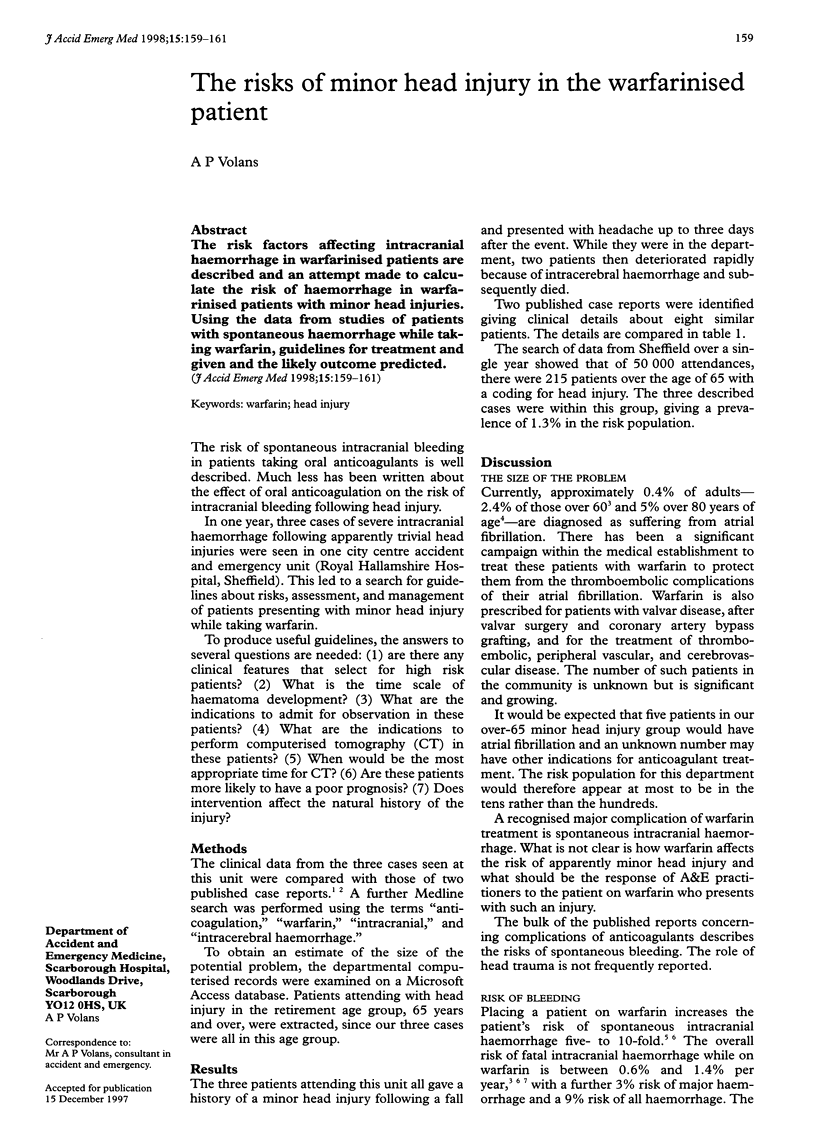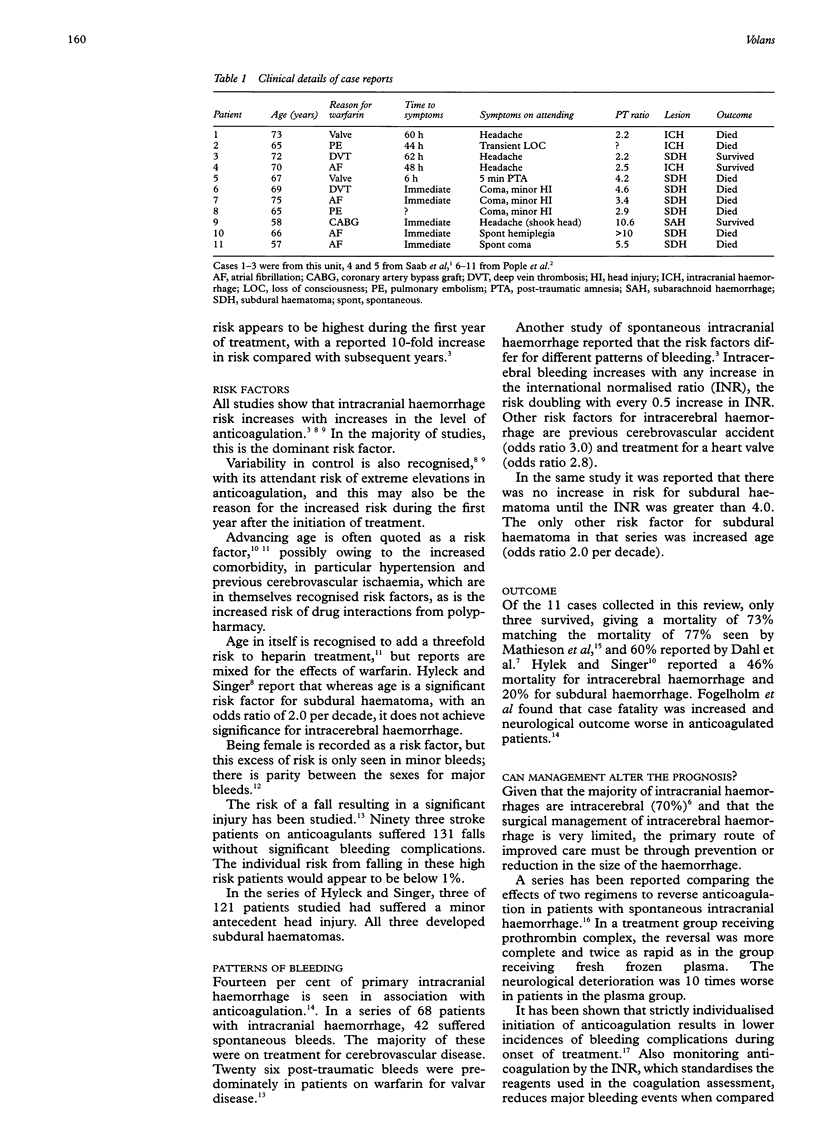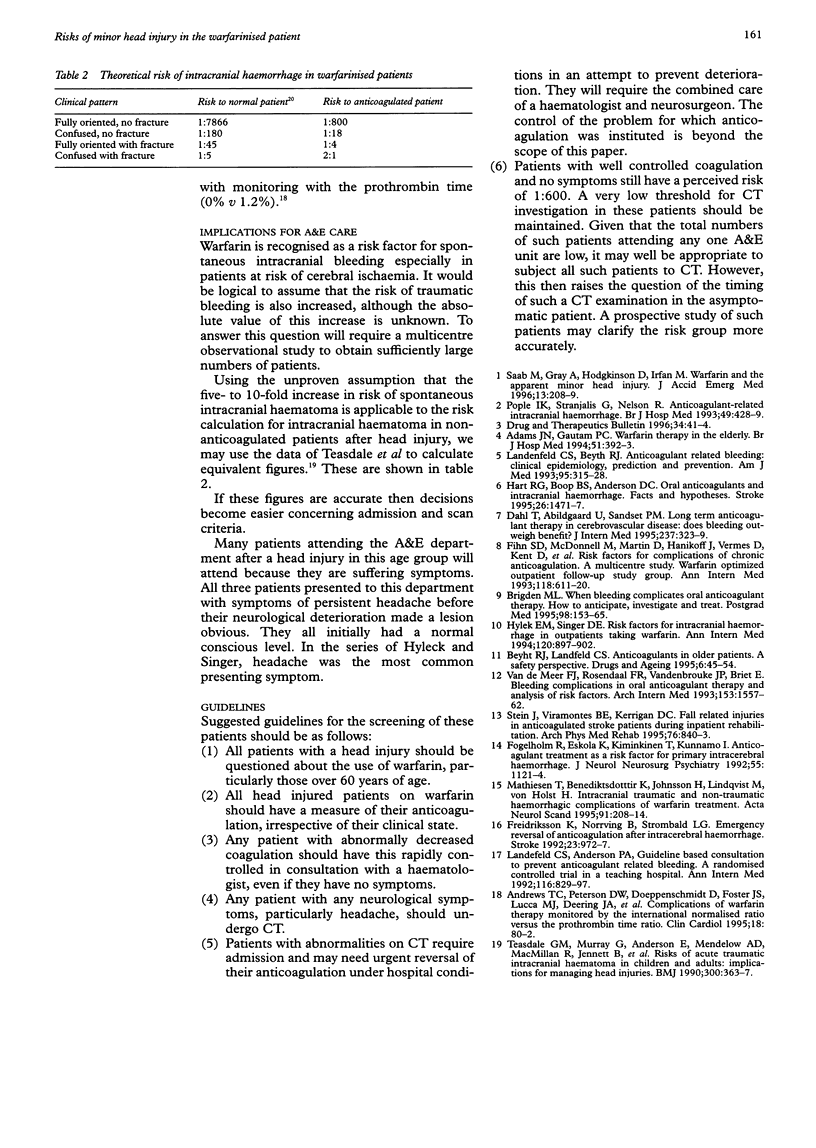Abstract
The risk factors affecting intracranial haemorrhage in warfarinised patients are described and an attempt made to calculate the risk of haemorrhage in warfarinised patients with minor head injuries. Using the data from studies of patients with spontaneous haemorrhage while taking warfarin, guidelines for treatment and given and the likely outcome predicted.
Full text
PDF


Selected References
These references are in PubMed. This may not be the complete list of references from this article.
- Adams J. N., Guatam P. C. Warfarin therapy in the elderly. 1994 Apr 20-May 3Br J Hosp Med. 51(8):392–393. [PubMed] [Google Scholar]
- Andrews T. C., Peterson D. W., Doeppenschmidt D., Foster J. S., Lucca M. J., Deering J. A., LaVeau P. J. Complications of warfarin therapy monitored by the International Normalized Ratio versus the prothrombin time ratio. Clin Cardiol. 1995 Feb;18(2):80–82. doi: 10.1002/clc.4960180208. [DOI] [PubMed] [Google Scholar]
- Beyth R. J., Landefeld C. S. Anticoagulants in older patients. A safety perspective. Drugs Aging. 1995 Jan;6(1):45–54. doi: 10.2165/00002512-199506010-00004. [DOI] [PubMed] [Google Scholar]
- Brigden M. L. When bleeding complicates oral anticoagulant therapy. How to anticipate, investigate, and treat. Postgrad Med. 1995 Sep;98(3):153-4, 159-62, 164-5, passim. [PubMed] [Google Scholar]
- Dahl T., Abildgaard U., Sandset P. M. Long-term anticoagulant therapy in cerebrovascular disease: does bleeding outweigh the benefit? J Intern Med. 1995 Mar;237(3):323–329. doi: 10.1111/j.1365-2796.1995.tb01182.x. [DOI] [PubMed] [Google Scholar]
- Fogelholm R., Eskola K., Kiminkinen T., Kunnamo I. Anticoagulant treatment as a risk factor for primary intracerebral haemorrhage. J Neurol Neurosurg Psychiatry. 1992 Dec;55(12):1121–1124. doi: 10.1136/jnnp.55.12.1121. [DOI] [PMC free article] [PubMed] [Google Scholar]
- Fredriksson K., Norrving B., Strömblad L. G. Emergency reversal of anticoagulation after intracerebral hemorrhage. Stroke. 1992 Jul;23(7):972–977. doi: 10.1161/01.str.23.7.972. [DOI] [PubMed] [Google Scholar]
- Hart R. G., Boop B. S., Anderson D. C. Oral anticoagulants and intracranial hemorrhage. Facts and hypotheses. Stroke. 1995 Aug;26(8):1471–1477. doi: 10.1161/01.str.26.8.1471. [DOI] [PubMed] [Google Scholar]
- Hylek E. M., Singer D. E. Risk factors for intracranial hemorrhage in outpatients taking warfarin. Ann Intern Med. 1994 Jun 1;120(11):897–902. doi: 10.7326/0003-4819-120-11-199406010-00001. [DOI] [PubMed] [Google Scholar]
- Landefeld C. S., Anderson P. A. Guideline-based consultation to prevent anticoagulant-related bleeding. A randomized, controlled trial in a teaching hospital. Ann Intern Med. 1992 May 15;116(10):829–837. doi: 10.7326/0003-4819-116-10-829. [DOI] [PubMed] [Google Scholar]
- Landefeld C. S., Beyth R. J. Anticoagulant-related bleeding: clinical epidemiology, prediction, and prevention. Am J Med. 1993 Sep;95(3):315–328. doi: 10.1016/0002-9343(93)90285-w. [DOI] [PubMed] [Google Scholar]
- Mathiesen T., Benediktsdottir K., Johnsson H., Lindqvist M., von Holst H. Intracranial traumatic and non-traumatic haemorrhagic complications of warfarin treatment. Acta Neurol Scand. 1995 Mar;91(3):208–214. doi: 10.1111/j.1600-0404.1995.tb00436.x. [DOI] [PubMed] [Google Scholar]
- Pople I. K., Stranjalis G., Nelson R. Anticoagulant-related intracranial haemorrhage. 1993 Mar 17-Apr 6Br J Hosp Med. 49(6):428–429. [PubMed] [Google Scholar]
- Saab M., Gray A., Hodgkinson D., Irfan M. Warfarin and the apparent minor head injury. J Accid Emerg Med. 1996 May;13(3):208–209. doi: 10.1136/emj.13.3.208. [DOI] [PMC free article] [PubMed] [Google Scholar]
- Stein J., Viramontes B. E., Kerrigan D. C. Fall-related injuries in anticoagulated stroke patients during inpatient rehabilitation. Arch Phys Med Rehabil. 1995 Sep;76(9):840–843. doi: 10.1016/s0003-9993(95)80549-4. [DOI] [PubMed] [Google Scholar]
- Teasdale G. M., Murray G., Anderson E., Mendelow A. D., MacMillan R., Jennett B., Brookes M. Risks of acute traumatic intracranial haematoma in children and adults: implications for managing head injuries. BMJ. 1990 Feb 10;300(6721):363–367. doi: 10.1136/bmj.300.6721.363. [DOI] [PMC free article] [PubMed] [Google Scholar]
- van der Meer F. J., Rosendaal F. R., Vandenbroucke J. P., Briët E. Bleeding complications in oral anticoagulant therapy. An analysis of risk factors. Arch Intern Med. 1993 Jul 12;153(13):1557–1562. doi: 10.1001/archinte.153.13.1557. [DOI] [PubMed] [Google Scholar]


